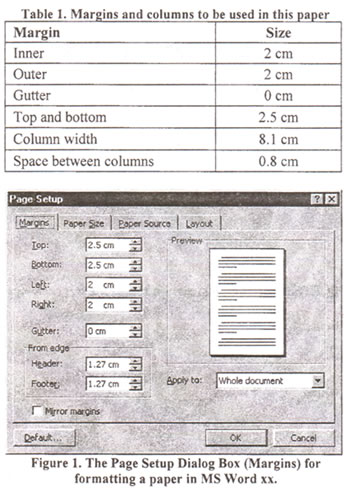INDICATIONS FOR PREPARING THE FULL PAPER FOR THE BULLETIN SCIENTIFIC |
|---|
| Publishing conditions |
A.A. Author and others (Times New Roman lOpt, bold)
Affiliation (name and address) E-mail: xxxperson@xxx.com
Please follow the following instructions and the format of this paper to allow the final publication look professional and consistent. 1. Maximum length of the submitted paper is 8 pages for general sessions and 10 pages for Keynote & Invited lectures. 2. Paper submission is by e-mail only. The format of submitted paper is Word AND pdf following this template. Authors are requested to submit BOTH of them if possible, and to put the PAPER REFERENCE NUMBER in the main-body of the e-mail. 3. Whenever the authors contact the WESC Secretariat, please quote the paper number given by the Organizing Committee. Heading Level 2 (Times New Roman 10 Bold Title Case) This text is in Times New Roman 10-point. This template, complete with header and footer formats, should make it easy to lay out your paper for the proceedings. When you have completed your abstract, check that you have deleted all instructions and headings in this template. The final paper has then been sent as e-mail attachment to the Committee Secretariat: marin_cor@yahoo.com, atdumitrescu@gmail.com This template paper is supplied in MS Word format or PDF file. Older word processors should still be able to read it in the PDF format version. Text should be single-spaced. Styles in this template should ensure that you achieve the correct format with a minimum effort. The paper should be structured into an introduction, main body (presentation of the contribution, results, discussion, etc), a concluding section and the list of references. 1.1 Margin and page allowance The page should be of A4 size (not letter or other sizes), with two columns and margins described in Table 1. For Microsoft Word users the Page Setup Dialog should appear as shown in Figure 1.  Page numbers should be avoided. The editor of the final WESC Proceedings will put them in a consistent form for the final document. 1.2 Guidelines for putting graphics in your paper Graphic objects such as charts, photos and line drawings should be in electronic form and be pasted into the document directly. Floating frames are useful for convenient positioning of graphics. Original line drawing, photos, etc should be scaned before insertion. If possible, use either JPEG or GIF format graphic files as they are more compact than bitmaps like BMP or PCT. By all means use color if it enhaces the meaning of the figures. Text may be wrapped around figures if desired. Number your figures Figure 1, Figure 2, etc with a short caption under each 9-point Times New Roman bold to distinguish it from the main text. The style Caption should be used, as in template. 1.3 Tables Tables should be labeled Table 1, Table 2, etc at the top of each table, with a short caption on the top of each table in 9-point Times New Roman bold to distinguish it from the main text. The style Caption should be used, as in this template. 1.4 Units Using units in the SI system is strongly recommended. 1.5 Equations Mathematical equations should be laid out wherever possible using an equation editor and be numbered consecutively as in this example (using lOpt Equations editor in Times New Roman): The equation should be separated by a blank line above and below, and the equation number should be aligned on the right margin. Variables should be written with 10 pt in italic format in the text and equations. 2. ACKNOWLEDGMENTS List here, where applicable, funding sources for the work described and other contributors. 3. REFERENCES All publications cited in the text should be presented in a list of references by a number in square brackets on the line (e.g. Since Rehman [1]), and the full reference should be given in the numbered list at the end of the paper. References should be written in the following format, with text size Times New Roman 9 pt.: Journals: [1] Rehman S. Solar radiation over Saudi Arabia and comparisons with empirical models. Energy 1998; 23(12): 1077-1082. Books: [2] Gumz W. Gas producers and blast furnaces. New York: John Wiley and Sons Inc., 1950. Reports: [3] Tribus M, Evans RB. A contribution to the theory of thermoeconomics, report no. 62-36. Los Angeles. CA: UCLA Engineering Department, 1962. Chapters: [4] Sintak Y. Models and projections of energy use in the Soviet Union. In: Steiner T, editor. International energy economics. London: Chapman and Hall. pp. 1-53. Conference or Symposium Proceedings: [5] Brabec CJ, Padinger R, Dyakonov V, Jummelen JC. Janssen RAJ, and Sariciftci NS, Realization of large area flexible fullerene-conjugated polymer photocells: a route to plastic solar cells. In: Molecular Nanostructures, Proceedings of the International Winterschool on Electronic Properties of Novel Materials, Kirchberg, 1998. References sourced via the world wide web: Example 1: [6] EWTS bulletin. A sixmonthly newsletter of the European Wind Turbine Standards (EWTS) project. Petten, the Netherlands; ECN-Renewable Energy. See also: http://www.awea.org/tech/ewts/index.html. Example 2: [7] Windpower Monthly, industry magazine, monthly published since 1985, ISSN 0901-7318, PO Box "lOO, DK-8420 Knebel, Denmark. Tel: +45- 86365465; fax: +45-86365626, email: mail@windpower-monthly.com, http://www.wpm.co.nz/ |